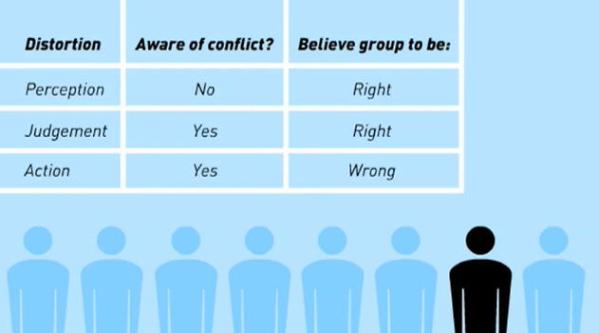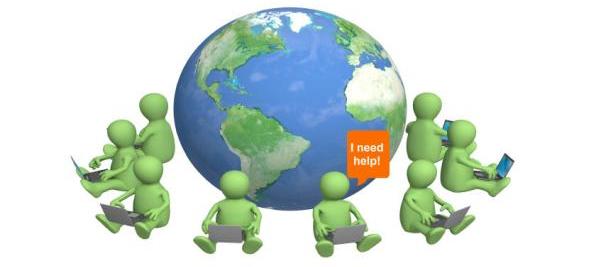![Neuroscience Reveals: Your Consciousness Is Connected To Everyone Else’s [TED Talk]](http://www.mutualresponsibility.org/wp-content/uploads/2012/09/ramachandran.jpg)
![Neuroscience Reveals: Your Consciousness Is Connected To Everyone Else’s [TED Talk]](http://www.mutualresponsibility.org/wp-content/uploads/2012/09/ramachandran.jpg)

The Asch Experiment: Can Social Influence Distort Your Perception?
We will conform to the group. We’re very social creatures. We’re very much aware of what people around us think. We want to be liked. We don’t want to be seen to rock the boat so we will go along with the group even if we don’t believe what people are saying, we still go along.” * This is a conclusion from what is known as “The Asch Experiment,” an experiment originally conceived in the 1950’s by Social Psychologist Solomon Asch, demonstrated in the video below [2 min.]: The 3 Levels of Distortion As indicated in Martin Shepard’s video about conformity [10 min.], “Asch proposed conformity could be explained by distortions occurring at any of three levels: perception, judgment and action.” At the action level: subjects believe the majority are wrong, but go along with them anyway. At the level of judgment: subjects perceive there is a conflict but reject their own judgment, concluding the majority are right. At the level of perception: subjects’ perceptions are genuinely distorted by the majority’s answers”. “If it’s true that the subjects’ perceptions are genuinely distorted, that means that group opinion has the potential to affect an individual’s information processing on a very profound level.” ** * Source: YouTube/The Asch Experiment **...
The Bystander Effect: Old Experiments Still Relative To Today’s Social Influences
And there you have a group of (effectively) strangers who were exerting the pressure not to intervene, not to help; and it’s very difficult to rebel!” This Bystander Effect is demonstrated in the following video [3 min.]: Using Other People’s Behavior As Clues To Reality There are, in fact, many reasons why bystanders in groups fail to act in emergency situations, but social psychologists have focused most of their attention on two major factors. According to a basic principle of social influence, bystanders monitor the reactions of other people in an emergency situation to see if others think that it is necessary to intervene. Each person uses others’ behavior as clues to reality. Since everyone is doing exactly the same thing (nothing), they all conclude from the inaction of others that help is not needed. This is an example of pluralistic ignorance or social proof. The other major obstacle to intervention is known as diffusion of responsibility. This occurs when observers all assume that someone else is going to intervene and so each individual feels less responsible and refrains from doing anything.” Bystander Effect Extends To Cyberspace The bystander effect also extends beyond reality and into cyberspace. Specifically, in a study performed by Markey (2000), the experiment focused on the amount of time it took a bystander to provide assistance. The researchers examined the effects of the gender of an individual seeking help by measuring participant response time (dependent variable). The perceived gender was manipulated by the usage of a male or female screen name in an Internet chat room (independent variable). The treatment conditions examined the number of...
New Twitter Study Shows Global Happiness On The Decline
In case you didn’t know, or have yet to receive a tweet about it, twitter is now being used for research. For instance at Cornell University a study was conducted which looked through over 500 million tweets to gauge users moods throughout the day: It turns out that we start our days positively (positive tweets), then our moods begin to decline throughout the day (at around midnight they pick back up again). A more recent study at the University of Vermont has also been conducted in which, “… more then 46 billion words written in Twitter tweets by 63 million Twitters users around the globe…” were analyzed. From this the researchers immersed themselves in a new perspective, In these billions of words is not a view of any individual’s state of mind. Instead, like billions of moving atoms add up to the overall temperature of a room, billions of words used to express what people are feeling resolve into a view of the relative mood of large groups.” Like in the Cornell study, The Vermont team then took these scores and applied them to the huge pool of words they collected from Twitter. Because these tweets each have a date and time, and, sometimes, other demographic information—like location—they show changing patterns of word use that provides insights in the way groups of people are feeling.” The implications of such research? The new approach lets the researchers measure happiness at different scales of time and geography… and stretched out over the last three years, these patterns of word use show a drop in average happiness.” So, the Cornell study measured...![Can Your Actions And Thoughts Influence People You Don’t Know? Prof. Fowler Explains [PopTech Video]](http://www.mutualresponsibility.org/wp-content/uploads/2012/09/james-fowler.jpg)
Can Your Actions And Thoughts Influence People You Don’t Know? Prof. Fowler Explains [PopTech Video]
If you tell someone they don’t influence anybody, they’re not going to do anything. But if you tell them they influence a thousand people they’ll change their lives. And that’s why I think it’s so critical for us to understand first and foremost how and why we are connected.” James Fowler, Professor of Medical Genetics and Political Science at University of California, is the co-author of Connected: How Your Friends’ Friends’ Friends’ Affect Everything You Feel, Think, And Do. The book describes conclusions from statistical analysis of data that was collected as part of a heart study in Framingham, Massachusetts, tracking over 12,000 individuals for 32 years. For the first time,” says Fowler, “we are able to get a birds’ eye view of networks like the networks that you live in.” Here is a 9 min. clip with highlights from Fowler’s talk on social networks at Pop Tech: Fowler describes a: Three Degrees of Influence” concept: “Your friends’ friends’ friends’ have an impact on you. They’re going to impact whether or not you’re obese, whether or not you smoke… whether or not you’re happy, whether or not you’re lonely, whether or not you’re depressed…” Fowler explains that this interconnection works two ways, We shape our networks but our networks also shape us.” Therefore, “If you do a kind act to a person they’ll do a kind act to another person and that will also spread…” And that this serves an “evolutionary purpose… Human social networks are in our nature… we have grown up over hundreds of thousands of years in these social networks.” Here is a link to Fowler’s full...
